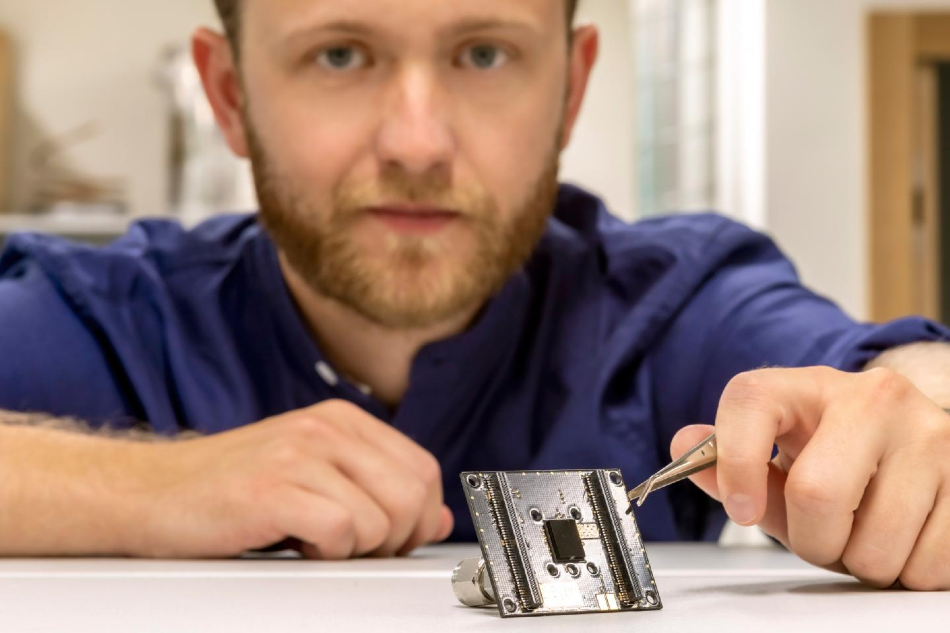 Paul Maierhofer with the result of his dissertation, the 12 x 9 x 3 millimeter small particle sensor, at the Institute for Electrical Measurement and Sensor Technology at Graz University of Technology. Image Credit: © Lunghammer - TU Graz
Paul Maierhofer with the result of his dissertation, the 12 x 9 x 3 millimeter small particle sensor, at the Institute for Electrical Measurement and Sensor Technology at Graz University of Technology. Image Credit: © Lunghammer - TU Graz
A tiny sensor could represent a huge breakthrough in the field of airborne particle detection, allowing measurements of air quality to be performed at much more localized scales.
Using established methods in the development of conventional measuring devices alongside cutting-edge fabrication and integration techniques researchers have managed to create the world’s smallest particle detector. A detector that is so small it could bring particle detection to the palms, wrists, and pockets of the general public, thus informing users of real-time localized fine dust and particle content in the air.
With particle pollution forming the second most common form of pollution in the US — just after ozone — and these particles often presenting hazards to health, the idea of personalized particle detection, as promised by this breakthrough, could be an important step in improving respiratory health.
Whilst the device — measuring in at a diminutive 12 x 9 x 3 mm — represents a significant breakthrough in measuring air quality on a personal scale, the very act of scaling down this tech is significant in its own right. The miniaturization has brought the sensor down to the very limits of what is feasibly possible technologically, requiring a few clever tricks to keep it functional.
The particle detector is the work of Paul Maierhofer, presented as part of his dissertation at the Institute of Electrical Measurement and Sensor Systems at the Graz University of Technology, Austria.
The sensor conforms to two of the University’s five institute’s strategic focal areas — namely ‘mobility and production’ and ‘sustainable systems’ — which have helped make it one of the world leaders in the academic study and development in the burgeoning field of particle measurement.
Fortunately, Maierhofer had a little help in the development of his breakthrough sensor. Not only did researchers from Silicon Austria Labs (SAL) step in to aid in the development of this tech, but the scientists were also supported by experts from the semiconductor manufacturer ams AG.
The Austrian tech company already has a reputation for producing small-scale high-performance sensors that fuse miniaturization with accuracy and sensitivity. Their products are already found across a wide range of platforms and applications — from individual consumers to industry, and from the medical field to the automotive market.
As one of ams Ag’s primary concerns is the interface of humans and sensor technology, it’s unsurprising that upon discovery of Mairhofer’s work they wanted to lend a hand.
Air Sensing Gets Personal
By miniaturizing airborne particle sensors, the researchers involved have made it possible to place said sensors into personal electronic devices. This allows smartphones, smartwatches, fitness wrist bands, and other devices to measure the air quality in the user’s immediate vicinity. This could be an important innovation for personal health, especially for individuals with breathing problems and other associated health issues.
Poor air quality threatens the health of all living things and there are a multitude of potential pollutants, each with their own associated effects on health and well-being. To contextualize this; a study by the European Environment Agency (EEA), suggests that over 400,000 people die prematurely every year in Europe alone as a result of particulate matter pollution.
In fact, air quality can have such a big impact on health that the U.S. Environmental Protection Agency issues color-coded air quality updates to alert people when pollution levels are high enough to be harmful.
Here’s the problem: whilst large-scale pollution monitoring is absolutely vital, and no one is suggesting that personal monitoring should replace it, air quality isn’t the same everywhere.
Particle pollution can build up in isolated areas for a multitude of reasons, and sometimes quickly. For example; increased activity on a certain stretch of road could result in a sudden unexpected build-up of pollution in a very localized ‘bubble.’A personalized reading on air particles in a region like this could allow the user to identify it and alter their behavior to account for it.
Going out for a jog? You could time it for after this local pollution ‘hot spot’ has dispersed., or take measures to avoid it.
Thus, Mairhofer’s device carries with it immense and obvious social benefits. But its applications don’t end with wearable devices. The researchers suggest that the sensor could also be integrated into devices located in both the home and outdoors to provide a variety of measurements previously unthought of.
Alexander Bergmann, head of the Institute of Electrical Measurement and Sensor Systems at TU Graz and doctoral supervisor of Paul Maierhofer, believes that the new sensor represents a significant step forward in air-quality monitoring.
Close-meshed and comprehensive monitoring of air quality has so far failed due to the size, complexity, and cost of currently available measuring sensors. Our particle sensor fills a gap here.
Alexander Bergmann, Head, The Institute of Electrical Measurement and Sensor Systems, TU Graz
Sources and Further Reading
Pelzl. C, [2020], ‘Styian technological innovation: The Smallest Particle Sensor in the World Made in Graz,’ TU Graz Media Service.
Riebeek. H, [2009], ‘Why Monitor Air Quality,’ NASA, Terra: the EOS Flagship.
‘About ams,’ [https://ams.com/about-ams], [Accessed 09/25/20]
Disclaimer: The views expressed here are those of the author expressed in their private capacity and do not necessarily represent the views of AZoM.com Limited T/A AZoNetwork the owner and operator of this website. This disclaimer forms part of the Terms and conditions of use of this website.